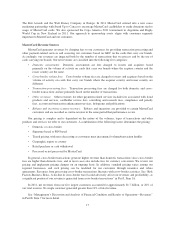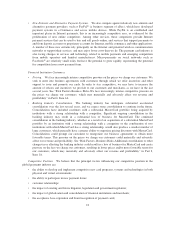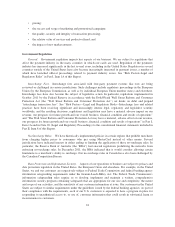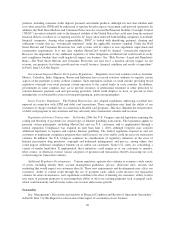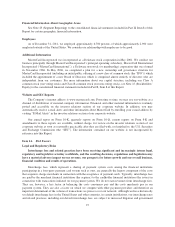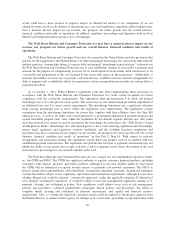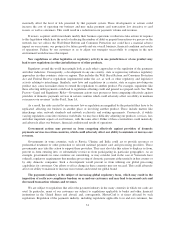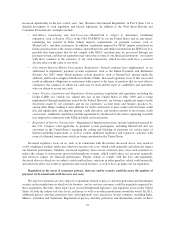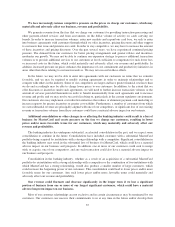MasterCard 2011 Annual Report Download - page 31
Download and view the complete annual report
Please find page 31 of the 2011 MasterCard annual report below. You can navigate through the pages in the report by either clicking on the pages listed below, or by using the keyword search tool below to find specific information within the annual report.Financial Information About Geographic Areas
See Note 23 (Segment Reporting) to the consolidated financial statements included in Part II, Item 8 of this
Report for certain geographic financial information.
Employees
As of December 31, 2011, we employed approximately 6,700 persons, of which approximately 2,900 were
employed outside of the United States. We consider our relationship with employees to be good.
Additional Information
MasterCard Incorporated was incorporated as a Delaware stock corporation in May 2001. We conduct our
business principally through MasterCard Incorporated’s principal operating subsidiary, MasterCard International
Incorporated (“MasterCard International”), a Delaware non-stock (or membership) corporation that was formed
in November 1966. In May 2006, we completed a plan for a new ownership and governance structure for
MasterCard Incorporated (including an initial public offering of a new class of common stock (the “IPO”)) which
included the appointment of a new Board of Directors which is comprised almost entirely of directors who are
independent from our customers. For more information about our capital structure, including our Class A
common stock (our voting stock) and Class B common stock (our non-voting stock), see Note 15 (Stockholders’
Equity) to the consolidated financial statements included in Part II, Item 8 of this Report.
Website and SEC Reports
The Company’s internet address is www.mastercard.com. From time to time, we may use our website as a
channel of distribution of material company information. Financial and other material information is routinely
posted and accessible on the investor relations section of our corporate website. In addition, you may
automatically receive e-mail alerts and other information about MasterCard by enrolling your e-mail address by
visiting “E-Mail Alerts” in the investor relations section of our corporate website.
Our annual report on Form 10-K, quarterly reports on Form 10-Q, current reports on Form 8-K and
amendments to those reports are available, without charge, for review on the investor relations section of our
corporate website as soon as reasonably practicable after they are filed with, or furnished to, the U.S. Securities
and Exchange Commission (the “SEC”). The information contained on our website is not incorporated by
reference into this Report.
Item 1A. Risk Factors
Legal and Regulatory Risks
Interchange fees and related practices have been receiving significant and increasingly intense legal,
regulatory and legislative scrutiny worldwide, and the resulting decisions, regulations and legislation may
have a material adverse impact on our revenue, our prospects for future growth and our overall business,
financial condition and results of operations.
Interchange fees, which represent a sharing of payment system costs among the financial institutions
participating in a four-party payment card system such as ours, are generally the largest component of the costs
that acquirers charge merchants in connection with the acceptance of payment cards. Typically, interchange fees
are paid by the merchant financial institution (the acquirer) to the cardholder financial institution (the issuer) in
connection with transactions initiated on our payment system. We do not earn revenues from interchange fees.
They are, however, a key factor in balancing the costs consumers pay and the costs merchants pay in our
payment system. They are also a factor on which we compete with other payment providers and therefore an
important determinant of the volume of transactions we process over our network. Although we have historically
set default interchange fees in the United States and other countries, in certain jurisdictions, our interchange rates
and related practices, including our default interchange fees, are subject to increased litigation and government
27


